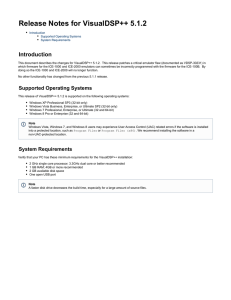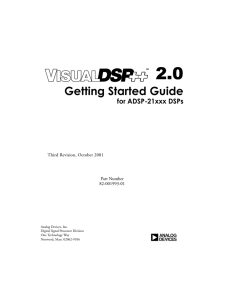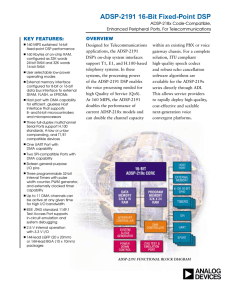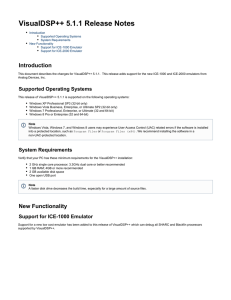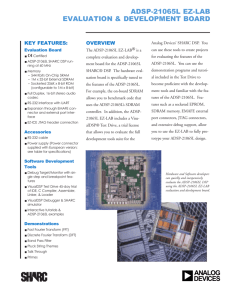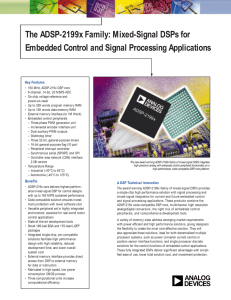VisualDSP++ 2.0 User`s Guide for ADSP-TSxxx DSPs
advertisement
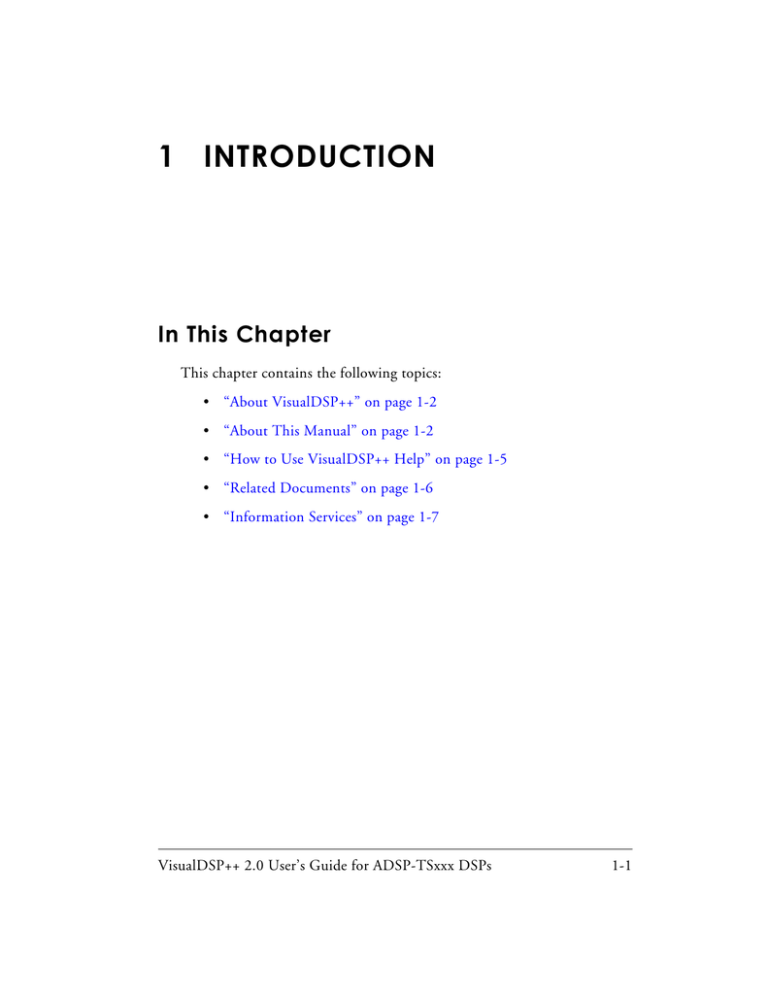
1 INTRODUCTION In This Chapter This chapter contains the following topics: • “About VisualDSP++” on page 1-2 • “About This Manual” on page 1-2 • “How to Use VisualDSP++ Help” on page 1-5 • “Related Documents” on page 1-6 • “Information Services” on page 1-7 VisualDSP++ 2.0 User’s Guide for ADSP-TSxxx DSPs 1-1 About VisualDSP++ About VisualDSP++ VisualDSP++ is a Windows-based software development environment for Analog Devices’ Digital Signal Processors (DSPs). About This Manual Purpose The VisualDSP++ 2.0 User's Guide for ADSP-TSxxx DSPs describes the features, components, and functions of VisualDSP++. Use this guide as a reference for developing programs for TigerSHARC Family processors. This guide does not include procedures for creating sessions and for building and debugging projects. For step-by-step instructions for developing a typical programming project, refer to VisualDSP++ online Help. Intended Audience This manual is primarily intended for DSP programmers who are familiar with Analog Devices’ DSPs. Before you begin actual programming, you should have a working knowledge of your processor’s architecture and instruction set. If you are unfamiliar with Analog Devices’ DSPs, you should supplement this guide with other documents (such as a DSP Hardware Specification) that describe Analog Devices’ DSP architecture and DSP instruction set. Before using this manual, review “Conventions” on page 1-4. 1-2 VisualDSP++ 2.0 User’s Guide for ADSP-TSxxx DSPs Introduction Contents Description Chapter contents are summarized as follows: • Chapter 2 — About VisualDSP++ Describes VisualDSP++ features, new Release 2.0 features, the program development process, projects, and Tcl scripting • Chapter 3 — Environment Describes the VisualDSP++ user interface, windows, environment customization, window operations, and the debugging windows • Chapter 4 — Debugging Describes debug sessions, code analysis tools, program execution operations, simulation tools, and plots • Appendix A — Reference Information Provides a glossary, information about C++ Run-Time Libraries and file types, keyboard shortcuts, command-line parameters, toolbar buttons, and text operations • Appendix B — Tcl Scripting Provides an overview of the Tool Command Language (Tcl), a reference for Tcl commands, and examples of Tcl scripting used to test DSP systems VisualDSP++ 2.0 User’s Guide for ADSP-TSxxx DSPs 1-3 About This Manual Conventions The following conventions apply to all chapters. Additional conventions, which apply only to specific chapters, appear throughout this document. Table 1-1. Notation Conventions Convention Example The following appear in bold: From the Debug menu, choose Restart and then press F5 to run the program. • Names of menus and menu commands • Toolbar buttons • Keyboard keys and key combinations • Tabs and tab pages • Dialog boxes • Dialog box control buttons and text boxes • Values typed or specified by the user • Words highlighted for emphasis The following appear in italics: • Variable information to be specified by the user • First occurrences of key terms or phrases defined in the text • Titles of books or other reference texts Examples of program code and system-generated messages appear in a mono-spaced, sans-serif font. In the End address box, type 0x4e4, but do not click Add. filename You run the DSP projects that you develop as sessions. Set a breakpoint at main() . The message “Halted” appears in the status bar. When you are instructed to enter a value in a text box, type or select the value but do not press the Enter key unless instructed to do so. 1-4 In the Start address box, enter a_dot_c. VisualDSP++ 2.0 User’s Guide for ADSP-TSxxx DSPs Introduction How to Use VisualDSP++ Help While using VisualDSP++, you can access online Help to obtain information about the environment or build tools. The following table explains how to use the VisualDSP++ online Help system: Table 1-2. VisualDSP++ Help Navigation For information about … Do the following... VisualDSP++ windows, menus, icons or dialog box controls Use one of these methods to access context sensitive help: VisualDSP++ operations, command syntax, or tools • Press the F1 key when the item (context) is selected • Press the context sensitive help button the item (context) and then select From the Online Manuals Help topic, open Portable Document Format (PDF) file versions of the user manuals in Adobe Acrobat Reader, which must be installed on your system. These manuals provide quick access to information about VisualDSP++. To access technical manuals from the VisualDSP++ environment: 1. From the Help menu, choose Contents. 2. On the Contents tab page, click the Reference icon . 3. Under Reference, click Online Manuals. The Online Manuals help topic appears in the right window pane. 4. Click to view the list of manuals. 5. Click the button to the left of the manual title to open the manual. You can copy Help text and paste it into your application. Be aware that the copied text may carry unwanted control codes. See the online Help for details. VisualDSP++ 2.0 User’s Guide for ADSP-TSxxx DSPs 1-5 Related Documents Related Documents For information about Analog Devices DSP development software, see the following publications: • VisualDSP++ 2.0 C/C++ Compiler and Library Manual for TigerSHARC DSPs • VisualDSP ++ 2.0 Assembler and Preprocessor Manual for TigerSHARC DSPs • VisualDSP++ 2.0 Linker & Utilities Manual for TigerSHARC DSPs • VisualDSP++ Kernel (VDK) User's Guide Your VisualDSP++ software distribution CD-ROM includes this and all the listed publications. To access these publications within VisualDSP++, use the Help Topics command on the VisualDSP++'s Help menu, click the Reference book icon, and select the Online Manuals topic. From the Help topic, you can open any of the manuals, which are in Adobe Acrobat PDF format. If you are not using VisualDSP++, you can manually access the PDF files from the CD-ROM by using Adobe® Acrobat®. Other documents related to your design DSP publications, such as Hardware and Instruction Set Reference Manuals, are available for download from: http://www.analog.com/industry/dsp/tech_doc/gen_purpose.html 1-6 VisualDSP++ 2.0 User’s Guide for ADSP-TSxxx DSPs Introduction Information Services For Product Information Analog Devices is online at www.analog.com. Our web pages provide information about our broad range of products: analog integrated circuits, amplifiers, converters, and digital signal processors. For information on our digital signal processors, visit our website at www.analog.com/dsp. Our web pages also provide access to technical information, documentation, product overviews, and product announcements. You can obtain additional information about Analog Devices and its products as follows: • FAX questions or requests for information to: In North America: (781) In Europe: 089/76 461-3010 903-557 • Access one of these DSP Division File Transfer Protocol (FTP) sites: ftp.analog.com ftp 137.71.23.21 ftp://ftp.analog.com VisualDSP++ 2.0 User’s Guide for ADSP-TSxxx DSPs 1-7 Information Services For Technical or Customer Support You can reach our DSP Tools Customer Support in the following ways: • E-mail questions to: dsptools.support@analog.com • Phone questions to: 1-800-ANALOGD • Visit our world wide web site at: www.analog.com/dsp • Telex questions to: 924491, TWX:710/394-6577 • Cable questions to: ANALOG NORWOODMASS • Contact your local ADI sales office or an authorized ADI distributor • Send questions by mail to: Analog Devices, Inc. DSP Division One Technology Way P.O. Box 9106 Norwood, MA 02062-9106 USA 1-8 VisualDSP++ 2.0 User’s Guide for ADSP-TSxxx DSPs
